Sanhe town, 32 kilometers from hefei, is a typical water town in the lower reaches of the Yangtze river with a history of more than 2,500 years. Read More
Chaohu Lake, Chao Lake, Chao Hu in Hefei
Chaohu lake is mainly located in Hefei, the capital of anhui province, and is shaped like a bird’s nest, hence its name. Read More
Chime-Long Paradise, King of Roller Coasters
Chime-Long happy world is located in Yingbin road, Panyu, Guangzhou, covering an area of more than 2,000 mu, with nearly 70 amusement facilities. Joy world has introduced equipment from leading amusement equipment companies in Switzerland, the Netherlands, Germany, Italy and the United States.
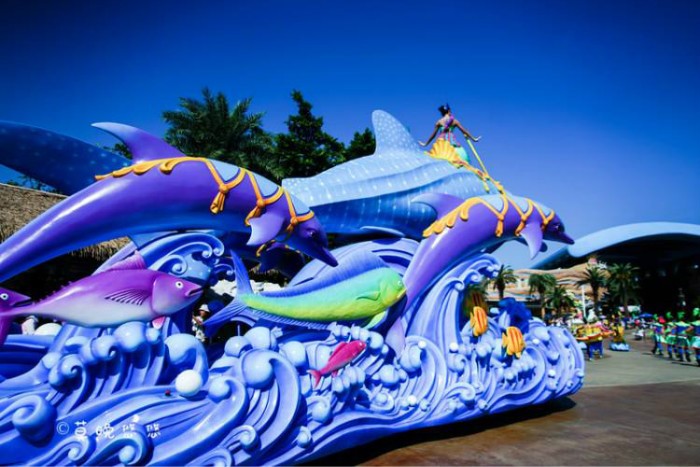
Among them: the “global king of roller coasters” vertical roller coaster, the guinness world record ten-ring roller coaster, the golden motorcycle roller coaster, the super pendulum, the only u-shaped skateboard in the old world and other world-class peak rides.
Cheilong happy world is located in guangzhou panyu yingbin road, the first phase covers an area of more than 1000 mu, nearly 70 amusement facilities. Joy world has introduced the equipment of the world’s leading amusement equipment companies in Switzerland, the Netherlands, Germany, Italy and the United States, including: vertical roller coaster, ten-ring roller coaster, motorcycle roller coaster, u-shaped ferris skateboard and super water wheel battle.
With more than 70 sets of amusement facilities, Chime-Long joy world is the largest amusement park in the world that has been invested and introduced into China. Most amusement equipment are imported from Europe, its design and technology to keep the international leading level, its particular eight most of Asia and the world, including: vertical roller coaster, ten ring roller coaster, motorized roller coaster, pegasus family a roller coaster, U skateboarding, super war, stunt, super large pendulum as well as to vertical roller coaster in the world at present, ten ring roller coaster for only the second set, while vertical roller coaster single investment alone more than 200 million yuan.
In addition to the attractions, the park also invites the American cowboy strength of the north American logging performance team to join. In addition, by the world’s top stunt director supervision of the entire production, Hollywood famous performance director led by a number of American Hollywood actors, in shock, wonderful stunt “crisis”, its spectacular scenes as Hollywood film reproduction. In addition, there are more than 200 elite performers from more than 20 countries composed of entertainment parade.
Since its opening, the happy world of Chime-Long has undergone great changes — from the 1.0 era of hardware amusement to the 3.0 era centered on satisfying tourists’ theme experience. Since 2012, when the new open the only Asian indoor scene exploration project “forest temple” to the world’s top global initiative, “” star, long lung happy world theme amusement to the world market to hand over a satisfied answer -” star battle “after the opening of the project, long lung happy world tourists increase of 50%, whereby long lung happy world new phantom of heaven and earth synchronization is complete.
This is only the first step in the long lung happy world new transformation, in the future, long lung happy world strong will introduce more new district, a new generation of the peak work in world theme park will emerge in endlessly, the emphasis on family common experience growing new amusement 3.0 era, different ages, different cultural backgrounds of the different needs of tourists here will be fully satisfied.
White Horse Temple, Which Has Remained Intact for Over 1,900 Years
White horse temple is a magnificent ancient architecture, has a history of more than 1900 years.
It was commanded by the emperor Ming of the han dynasty. In the year 64 of the eastern Han dynasty, the emperor sent people to study Buddhism in the western world. Three years later, two eminent Indian monks, she muten and Zhu Faran, came with the group. They brought a white horse with buddhist sutras and buddhas on its back. This is the first time Buddhism has appeared in China.
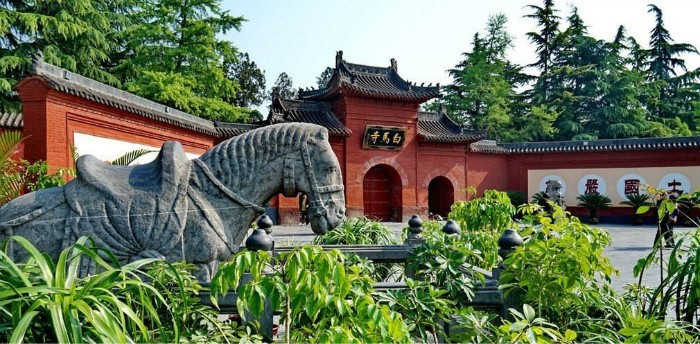
To express his gratitude to the two monks and their white horse, the emperor ordered a monastery to be built the following year and named it the white horse temple. During this time, the two monks were busy translating buddhist sutras in the temple, until they finished the Chinese sutras of the forty-second chapters, which attracted many monks, meaning that the temple became the center of buddhist activity in China. Because of this, the temple is known as the “home of the founders” and “the cradle of Chinese Buddhism”.
White horse temple ancient trees towering, solemn and solemn. Outside the gate, there is a pond with a fence around it. There are lovely fish in the water. Releasing animals is a matter for believers. Cross a stone bridge and you can enter the temple. On the east and west sides of the gate are the tombs of she and zhu falan, one of the six most famous attractions here. There is a tablet pavilion in the east corner. The Chinese characters on the tablet are the work of Chinese calligrapher and abbot shaman wencai, designed during the yuan dynasty (1271-368). Written in his familiar free and easy style, they describe the history of the white horse temple.
The temple of the heavenly king, the hall of the great Buddha, the hall of the great Buddha, the hall of the great Buddha, the hall of the guiding path and the cool terraced fields are all lined up in the temple, just as they were when they were first built.
The hall dates back to the yuan dynasty. In the middle of the hall sat a laughing Buddha, maitreya Buddha. It is said that the Buddha once incarnated as a beggar monk with a wallet containing all the treasures of the world. The shrine, made of wood and carved with more than 50 lifelike dragons, is a typical example of qing dynasty (1644-1911) culture. Maitreya is flanked by four solemn “heavenly Kings”. Each has a different weapon, four of which are clay sculptures cast in the qing dynasty.
White Cloud Mountain National Forest Park
Baiyun mountain national forest park was established in September 1992. It is located in the southern song county seat of luoyang, the hinterland of foulu mountain ridge, with a total area of 168 square kilometers (64.9 square miles). It invites visitors to refresh themselves in its natural beauty.
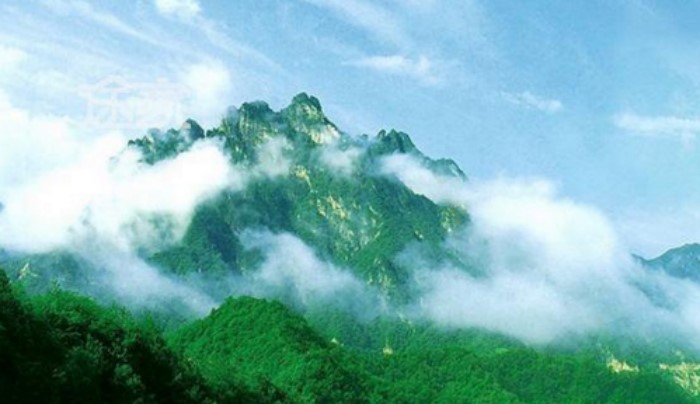
The forest coverage rate is 98.5%, which is in the transitional zone between warm temperate zone and subtropical zone. The vegetation of north and south China coexists here. In baiyun mountain national forest park, 204 species of animals, 1991 species of plants, 3000 species of insects. For example, there are ancient and rare plants: dendrobium and alpine rhododendron, as well as some rare animals: giant salamanders, leopards and golden eagles. It is a good place to appreciate the original beauty of nature. Water curtain cave, folding waterfall and fairy pool are all here. The scenery is beautiful beyond description.
At 2,150 meters (7,054 feet) above sea level, baiyun peak is one of the main peaks of funiu mountain. It is shrouded in clouds all year round, just like a fairyland on earth. There are folk songs and proverbs that say mountains can indicate changes in weather through the position of the surrounding clouds. Dazzling and fascinating, it’s the perfect place for climbers to find something new.
This is the highest point of the funiu mountain ridge, considered the highest point in central China, rising 2,216 meters (7,270 feet) above sea level. The mountain peak is shaped like a crown and seems to reach straight into the sky. From the top of the mountain, visitors can enjoy magnificent panoramic views of the vertical distribution of vegetation, as well as the fascinating sunrise and sea of clouds.
Small huangshan is called small huangshan because it reminds people of the famous huangshan in anhui province, which is famous for its strange rocks. The beauty and strangeness of small huangshan are fascinating. Various rocks have been given strange names, such as the sea fairy, the twin stone and the bird’s nest stone.
These waterfalls are formed by the white river, which rises from the peak of the jade emperor. It has a constant supply of water, rushing down, washing out the scattered waterfalls and deep pools. The jiulong waterfall, qinglong waterfall and the amur pool are the most attractive attractions in the area. In addition, there is an 814-foot bungee jump, considered the highest in Asia, offering visitors a chance to challenge their metter.
The park’s average summer temperature is below 18 degrees Celsius (64.4 degrees Fahrenheit), with the highest temperature below 26 degrees Celsius (78.8 degrees Fahrenheit). It is a magnificent summer resort, but the blooming flowers in spring, the clear sea of water and clouds in summer, the deep red leaves in autumn and the majestic baiyi mountains in winter make baiyun mountain national forest park a year-round Chinese resort.
Detian Waterfall, Which Makes a Very Deep Impression on You
The detian waterfall scenic spot is located in daxin town, chongzuo city, guangxi zhuang autonomous region, about 145 kilometers (90 miles) from downtown nanning and surrounding Vietnam. This scenic spot has more than 40 tourist attractions. Among them, the most striking is Ban gioco-detian falls.
The waterfall crosses the border between China and Vietnam and is connected to banjuk falls in Vietnam. It has the reputation of being the second largest transnational waterfall in the world. Perhaps you have seen the famous Niagara Falls. You are impressed by its majesty. Similarly, the majestic tokuda waterfall gives a sense of breathtaking magnificence.
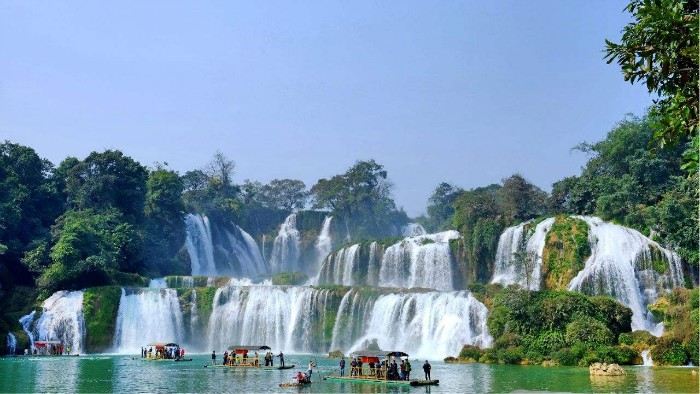
Below the tokuda falls is a deep pool more than 200 meters (0.12 miles) wide and more than 30 meters (0.02 miles) deep. There are many big fish in the pond and the fish are delicious. So the villagers who live there often come to the pond to catch fish. They usually sing folk songs while casting nets. The wild songs echoed in the mountains, a joyous, carefree, lively atmosphere.
Besides the detian waterfall, there are many other attractions waiting for you to visit, including heishui river, qiaomiao lake, guichun boundary river, shadun waterfall, no. 53 waterfall, as well as numerous cultural relics and rare animals. Abundant rainfall and moderate temperatures have brought evergreen to the picturesque landscape.
The blackwater river, as it is called in English, is dotted with verdant plants and strange hills. Of course, the water is not black. It gets its name from the black reflections of trees and hills. When you row on the heishui river, you can see the rotating water wheels, the houses of the minority zhuang people, the terraces and the laboring farmers.
Qiaomiao lake covers an area of about 5000 mu, surrounded by green mountains. The lake was as calm as a mirror. The mountains, trees and clouds reflected on the lake like a picture. Boating on miaomiao lake, listening to folk songs, enjoying the bright moon, enjoying the peace granted by heaven in the earth.
Guichun river originated in jingxi, baise city, guangxi. It flows into Vietnam and then back to China. The two countries are bordered by this river. On one side are zhuang-style buildings, on the other side is the face of another country. It’s interesting to think about the difference.
Shatun waterfall is another famous waterfall in the scenic area. The waterfall runs down seven terraces. Compared with the tokuda falls, the sandun falls are not so magnificent. It looks like a gentle woman who associates herself with the fascinating nature.
China National Flower Garden in Henan Province
Established in 2001, the national park of China is located on the south bank of luojiang, luoyang city, henan province. Covering 255 acres, it is the largest peony park in China. China’s national parks have bred about half a million 9-color peonies and two million peonies of more than 1,000 different species. Among them, a 100-year old, 2-meter (7-foot) tall giant peony known as the “flower goddess” has caught people’s attention. April to early may is the best time to see peonies in full bloom in China’s national parks. Visitors can enjoy peonies, pavilions, lakes and mountains, as well as distinctive architecture. In the history of the sui and tang dynasties (581-907), traditional imperial garden art and peony flowers were perfectly combined in China’s national gardens. Here are the main sightseeing areas.
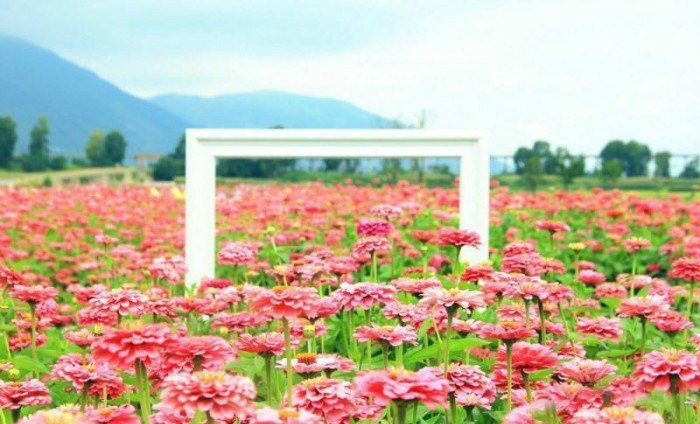
The place consists of burnt peonies and a huge gourd with three golden balls. There is a legend that the peony was brought up by the Taoist god taishang lao-jun who used fire to create golden jade, so it is called burnt peony.
The pavilion was inspired by a story about qiuweng and peonies. Qiu weng is a farmer who likes to plant peonies. He takes care of them as his family. The attraction consists of five pavilions, one on two floors and one on four. Visitors can see all kinds of rare peonies here.
The two pavilions here merge into one, like two qiao peonies, a treasure flower with two different colors. The tree was known as “big Joe” and “little Joe” during The Three Kingdoms period (AD 220-265) in China.
The lake covers more than five acres. Weeping willows flaunted on the Banks of the river, and countless fish swam in the river. Visitors can lie on the grass by the lake and feel the smell of spring. The mountain is man-made and has many jagged caves. The waterfalls flow down, creating a breathtaking landscape that brings the park to life.
This particular garden covers an area of more than 2,000 square kilometers (2,400 square yards). The aim of the design was to integrate butterfly elements into the landscape. During the peony cultural festival from April to early may, visitors can see more than 20,000 butterflies dancing around the peonies, which is a fascinating sight.
This is the first and only private writing museum in luoyang. Founded by the two brothers in 2012, it aims to preserve, protect and display cultural relics from different regions and dynasties. There are now more than 2,000 written artifacts and samples.
Shuanglin Temple and Zhenguo Temple in PingYao Ancient City
Pingyao County is 58.4 miles southwest of Taiyuan. This small county was noted for some magnificent residences in ancient traditional styles rather than any appeal in natural beauty.When Pingyao was inscribed on the UNESCO list as a World Heritage Site, two temples were added to the town itself as being worthy of preservation.
Shuanglin Temple
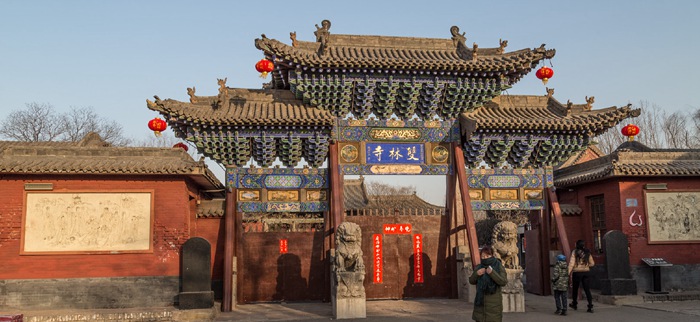
Located in the Qiaotou Village about six kilometers (four miles) to Pingyao Ancient City, the Shuanglin Temple is reputed to be the ‘ancient painted sculptures museum’. It houses more than 2,000 colorful sculptures reflecting the exquisite skills of the artisans of the Song, Yuan, Ming and Qing Dynasties. In 1997, it was included in the World Heritage List by UNESCO as an important cultural site of Ping Yao City in 1997.
Reconstructed in 571, the Shuanglin Temple has a history of about 1,400 years. It consists of ten large and small halls, and the sutra chanting hall and the monks’ rooms.
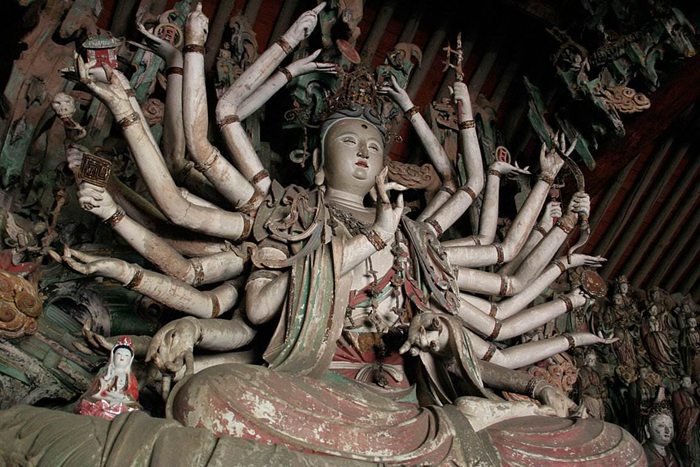
In Chinese, Shuang means two or double, and Lin, forest. The temple got its name from a Buddhist story. According to the Buddhist sutra, Sakyamuni who was the founder of Buddhism, entered nirvana under two trees; Hence, its name Shuanglin.
Most valuable colorful sculptures housed in Shuanglin Temple are made with wood moulds from Ming Dynasty, which kept traditions of the former dynasties of Tang Dynasty to Yuan dynasty. As a part of Pingyao Ancient Town, which is listed a world Heritage site, Shuanglin Temple attracts lots of tourists every year for its long history and profound culture.
Zhenguo Temple
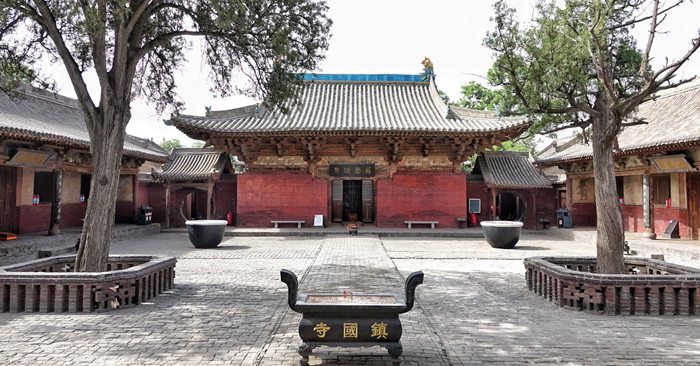
Zhenguo Temple is about 12 kilometers (about 7.5 miles) away from the northeast of Pingyao Ancient City, occupying an area of 10,892 square meters (about 2.7 acres). It was first built in 963 in the Northern Han Dynasty (951 – 979). Its 44 ancient constructions of different periods houses 62 painted clay sculptures, over 100 frescoes and more than 20 stone tablets which truly record the easy fusion of the Confucianism, Buddhism and Taoism in China. The fairy tale of Lu Ban, the ancient carpenter master building the temple adds a desolate mysterious color to the temple. Especially, the original structure of its Ten-thousand Buddha Hall constructed in the Five Dynasties Period (907-960) has never been changed for over 1000 years though it has undergone many restorations in previous different periods. The fine frescoes of the Beiqi Dynasty on the hall’s walls are also rarely seen in China, as provide precious evidences for studying the Chinese development history of architecture and fine arts.
The Thousand Buddha Hall is the oldest architecture in Zhenguo Temple; it is also one of the oldest existing wood-made architecture in mainland China. Different from other wood-made buildings, the whole architecture was miraculously built without nails. It is the rigid structure, strict materials and highly skilled technique employed with principle of statics that make this building stand stably for more than 1000 years. It is the gem of ancient Chinese architectures.
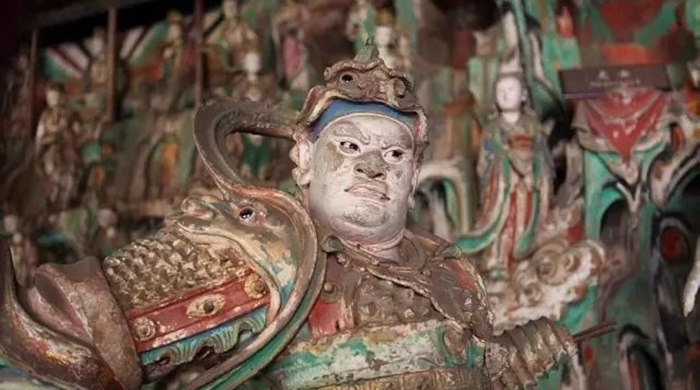
Painted sculptures in Zhenguo Temple are also precious. In Thousand Buddhist Hall, 11 of the 14 statues were made in Five Dynasties. Five Dynasties is a period full of wars, only several ancient buildings of that time are preserved, let alone painted sculptures. Except for the few ones in Mogao Grottoes in Dunhuang, Zhenguo Temple is the only temple that preserves painted sculptures of Five Dynasties. Although the quantity of the painted sculptures in the Zhenguo Temple is limited, they are of utmost importance in researching the sculpture evolution especially in Tang and Song dynasties.
Pingyao Ancient Town, Famed for the China’s First Bank
Pingyao is a well-preserved “ancient city” famous for its ancient buildings and China’s first bank. Located between Beijing and xi ‘an in northern China, it is suitable for lovers of photography and history.
It is an outstanding han Chinese city in the Ming and Qing dynasties, and its historical features are well preserved. Pingyao ancient city wall, Shuanglin temple and Zhenguo temple are national protected cultural relics and world heritage sites.
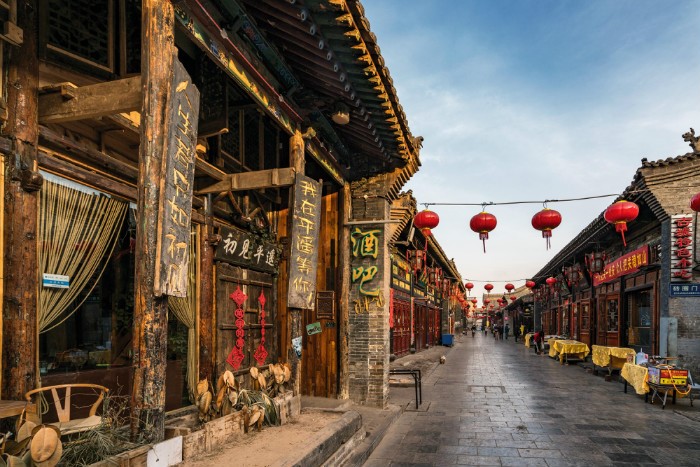
Pingyao was the birthplace and earliest bank of shanxi merchants, and was the financial center of Shanxi Province during the Ming (1368-1644) and qing (1644-1911) dynasties.
Pingyao was included in UNESCO’s world heritage list on December 31, 1997 because of its well-preserved urban landscapes from the Ming and qing dynasties.
Pingyao is a famous city in China’s tourism industry. Although it no longer thrives on trade, its historical and cultural heritage makes it one of China’s premier tourist destinations.
Pingyao is temperate continental climate, hot summer and cold winter. The average maximum temperature is 29°C(84°F) in July and 2°C(35°F) in January. The middle seasons offer the most comfortable weather, the freshest air in the summer and the lowest prices in the winter.
Summer is usually hot, and July and August are the wettest months, with 100 millimeters (4 inches) of rain. Most of the rain in pingyao falls in summer, drying up the rest of the year.
In the middle of winter, strong winds blow in from the north and nighttime temperatures are around 10°C (14°F). The temperature difference between day and night is large, and the air quality is poor in winter, but not as good as in big cities in the north.
Shanghai People’s Park, Renmin Park
People’s park, also known as people’s park, has a total area of 98,200 square meters (24.3 acres). It starts from xizang middle road in the east, reaches huangpi north road in the west, reaches nanjing west road in the north, and reaches people’s square in the south. The park has eight gates; The main gate is located at number 10. It’s on nanjing west road.
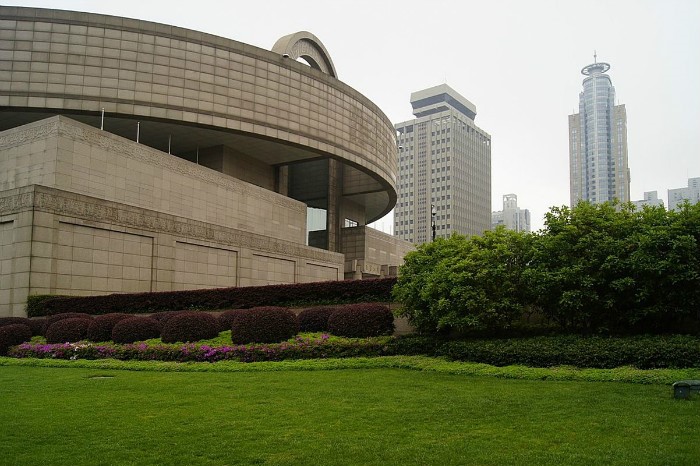
The park can be divided into three regions: the eastern region, the central region and the western region. The most notable event in the east is the commemoration of the May 3rd movement. The South Pole stone, the Shanghai museum of contemporary art, the teahouse, the amphitheatre and the dance hall are all situated in the vast middle ground. In addition, visitors can rest in the jungle, play chess or have a picnic on stone tables and benches. Compared with the eastern and central regions, the western regions have a lot of landscape architecture, including pavilions, cloisters, rockeries, pools and awnings.
The memorial to the May 3rd movement (the anti-imperialist movement of 30 May 1925) is located in the northeast of the park. On May 30, 1985, it was founded to commemorate the 60th anniversary of the May 3rd movement. The memorial was inaugurated on 30 May 1990. Covering an area of 4,000 square metres (1 acre), it is made up of a main stainless steel sculpture, a bronze sculpture and three pieces of granite.
The main sculpture is 15.6 meters (17 yards) high, 21 meters (23 yards) wide and weighs 50 tons (55 short tons). It says “May 30”. These shining inscriptions reflect the optimism and enthusiasm of the Chinese people. The bronze statue is 3 meters (3.3 yards) tall and 4 meters (4.4 yards) wide. The two workers in the picture look serious, showing the courage and determination of the Chinese workers. The granite in the middle is 5 meters (5.5 yards) high and 24 meters (26 yards) wide, with inscriptions of Chen yun and lu ding who participated in the May 3rd movement. In addition, the history of the movement is inscribed on two other stone tablets, 4 meters (4.4 yards) high and 12 meters (13 yards) wide.









